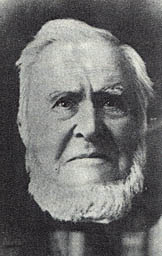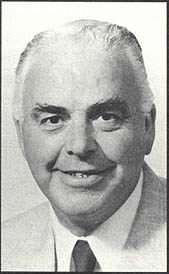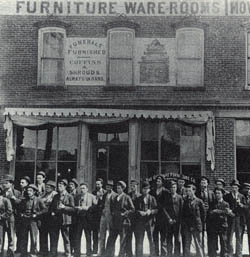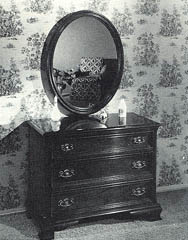  |
| 1. John Gibbard, Founder (1813-1908). 2. Bruce McPherson, Current President and Owner of Gibbard Furniture Shops. |
Not many companies can boast 150 years of continuous operation—let alone a century and a half under control of only two families. That both these families also share a love of fine furniture craftsmanship with roots in centuries of tradition is nothing short of phenomenal.
Yet the Gibbard Furniture Shops Limited is such a company. It began in 1835 in the small village of Napanee, Ontario, the creation of John Gibbard, a Canadian-born cabinetmaker whose English ancestors had come to Canada in the early 1800s. In 1985 Gibbard marked its sesquicentennial with the production of a limited edition solidwalnut tea wagon it originally designed in the 1920s. A classic piece of Canadiana, the original tea wagons have graced the drawing rooms of many Canadian homes throughout the years. Bruce McPherson, current president and owner of Gibbard, puts the company's philosophy simply but eloquently when he says that quality in craftsmanship and in people go hand in hand.
"Quality, like good housekeeping, has to be there every day," he says. "But good people are what make a business. I have been fortunate to have good people. Our people have been with us for years—many for more than a quarter-century. In fact, from 1944 to 1984, more than 40 of our employees had more than 50 years' service on retirement. "That's a factor that can't be discounted in the manufacture of fine furniture. Our people have the patience, understanding and tolerance to work with wood—to treat it as the living material is—to bring out its beauty in the finished product.
"With us, quality is an everyday thing.
One has to believe in it. Every employee helps to maintain it. We put quality
materials and craftsmanship into our furniture, and we have quality dealers
who market it. We look on what we've got as a legacy from the past, and
we hope to hand it down as a future heirloom."
  |
| 1. John Gibbard, Founder (1813-1908). 2. Bruce McPherson, Current President and Owner of Gibbard Furniture Shops. |
No company can reach the venerable age of 150 without ups and downs. Gibbard is no exception.... Its founder, John Gibbard, watched helplessly as his mill burned to the ground in 1864. By 1868, when the ink was barely dry on the Confederation charter, the mill was operating again, this time greatly expanded, with John Gibbard's son, William T., entering the business. By 1871, the company made the decision to close down its sash, door, and coffin business, concentrating totally on furniture manufacture—only to see its plant burn to the ground again, in 1874. By 1875 it was once more up and running. Over the decades, other members of the Gibbard family took their places at the management helm. George succeeded William. Ernest took over from George. Then, in 1940, the McPherson family bought the venerable firm and began a process of renewal that continues to the present day.
"The 30s were not good years for most companies, and Gibbard was no exception, says Bruce McPherson. My father Jack, sales manager in the 1920s, launched a building and re-equipping program that brought the company back from the brink. He died suddenly in 1944 and never lived to see his reforms in effect, but my mother, Janet, then David S. Roffey, the president who succeeded her, followed the program to its completion."
When Bruce McPherson assumed the chief
executive's chair, the company was prepared to face rapid post-war expansion
and competition. A major reform he instituted had nothing to do with manufacturing,
but with how the company marketed its products. Today the solid mahogany
and cherry furniture, the company's hallmarks, are distributed across Canada
through a select group of dealers—who are an integral part of the Gibbard
operation. "Styles of furniture have changed somewhat over the years. But
our commitment to quality is so stringent that any planned increase in
production is dependent on our ability to maintain that quality. Our dealers
know that, and our furniture sells consistently as a result."
  |
| 1. Gibbard's "coffins and shrouds" employed 28 in 1880. 2. One of the 70 Different Pieces Made With Solid Honduras Mahogany and Solid Wild Black Cherry. |
The company, with 170 employees, has just completed an extensive capital expenditure program. In addition to adding buildings, kilns and machinery, Gibbard has increased its capacity for hydro power and air replacement requirements by 50 per cent. This not only anticipates future expansion but will provide even higher quality and efficiency in the competitive times ahead. Gibbard's work has been recognized both by the government and by the industry itself. The company has several times been awarded the coveted Ontario Trillium Award for design and marketing excellence, and its products have been purchased by the federal government to furnish more than 75 Canadian embassies abroad.
"We have pride in our people and our people have pride in their product," says McPherson, paying particular tribute to four key employees who helped set Gibbard on the road to contemporary success. They are General Manager Werk Poole, Sales Manager Bill Roffey (son of a former company president), and Lily and Barney Griffin, a husband-and-wife team whose joint service represented 110 years with the company.
"The company has consistently invested as much in its people as it has in equipment," says McPherson. "It maintains a profit-sharing program based on profits and production. Promotion is traditionally from within. Every effort is made to encourage the development of business systems encouraging quality. "I'm proudest of the fact that since 1940, with the exception of a small cutback during the 1982 recession, Gibbard has a record of continuous, full employment," he says.
This is unique in an industry that has seen so many changes and casualties over the years. It is also an indication of Gibbard's success. The company has ongoingly supported community and industry activities. Bruce Sr., for instance, has served two separate terms as president of the Canadian Council of Furniture Manufacturers. Other Gibbard people have also served their community and industry. Today, Bruce's sons, Jack, Bruce and Tim, have assumed responsibilities in the business, pointing toward the day when the third generation of the family will assume control. But one thing will remain constant, says McPherson.
"Times may change, but quality does not. Today our company is synonymous with fine furniture. And we're going to keep it that way!"